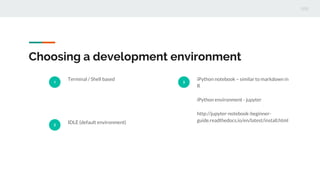Basic of python for data analysis
- 1. Confidential Customized for Lorem Ipsum LLC Version 1.0 Basic of Python for Data Analysis Pramod Toraskar.
- 2. Why learn Python for data analysis? Here are some reasons which go in favour of learning Python: ● Open Source – free to install ● Awesome online community ● Very easy to learn ● Can become a common language for data science and production of web based analytics products.
- 3. Choosing a development environment 1 Terminal / Shell based 2 IDLE (default environment) 3 iPython notebook – similar to markdown in R iPython environment - jupyter http://jupyter-notebook-beginner- guide.readthedocs.io/en/latest/install.html
- 4. Recall Python libraries and Data Structures Lists, Strings, Tuples, Dictionary.. Following are a list of libraries, you will need for any scientific computations and data analysis: ● NumPy (Numerical Python). The most powerful feature of NumPy is n-dimensional array. This library also contains basic linear algebra functions, Fourier transforms, advanced random number capabilities and tools for integration with other low level languages like Fortran, C and C++ ● SciPy (Scientific Python). SciPy is built on NumPy. It is one of the most useful library for variety of high level science and engineering modules like discrete Fourier transform, Linear Algebra, Optimization and Sparse matrices.
- 5. ● Matplotlib for plotting vast variety of graphs, starting from histograms to line plots to heat plots.. You can use Pylab feature in ipython notebook (ipython notebook –pylab = inline) to use these plotting features inline. If you ignore the inline option, then pylab converts ipython environment to an environment, very similar to Matlab. You can also use Latex commands to add math to your plot. ● Pandas for structured data operations and manipulations. It is extensively used for data munging and preparation. Pandas were added relatively recently to Python and have been instrumental in boosting Python’s usage in data scientist community. ● Scikit Learn for machine learning. Built on NumPy, SciPy and matplotlib, this library contains a lot of efficient tools for machine learning and statistical modeling including classification, regression, clustering and dimensionality reduction. ● Statsmodels (statistical modeling), Seaborn (statistical data visualization), Bokeh (creating interactive plots, dashboards and data applications on modern web-browsers. It empowers the user to generate elegant and concise graphics in the style of D3.js.)
- 6. Key phases
- 7. The 3 key phases 01 Data Exploration: Finding out more about the data we have ● numpy ● matplotlib ● Pandas import pandas as pd import numpy as np import matplotlib as plt df = pd.read_csv("/home/ptoraska/Downloads/Loan_Prediction/train.csv") #Reading the dataset in a dataframe using Pandas QUICK TIP Try right clicking on a photo and using "Replace Image" to show your own photo.
- 8. Data Exploration Once you have read the dataset, you can have a look at few top rows by using the function head() df.head(10)
- 9. The 3 key phases 02 Data Munging: Cleaning the data and playing with it to make it better suit statistical modeling. 1. There are missing values in some variables. We should estimate those values wisely depending on the amount of missing values and the expected importance of variables. 1. While looking at the distributions, we saw that Applicant Income and Loan Amount seemed to contain extreme values at either end. Though they might make intuitive sense, but should be treated appropriately.
- 10. Check missing values in the dataset Let us look at missing values in all the variables because most of the models don’t work with missing data and even if they do, imputing them helps more often than not. So, let us check the number of nulls / NaNs in the dataset df.apply(lambda x: sum(x.isnull()),axis=0)
- 11. The 3 key phases 03 Predictive Modeling: Running the actual algorithms and having fun After, we have made the data useful for modeling, The Skicit- Learn (sklearn) is the most commonly used library in Python for this purpose
- 12. Building a Predictive Model in Python sklearn requires all inputs to be numeric, we should convert all our categorical variables into numeric by encoding the categories. This can be done using the following code: from sklearn.preprocessingimport LabelEncoder var_mod = ['Gender','Married','Dependents','Education','Self_Employed','Property_Are a','Loan_Status'] le = LabelEncoder() for i in var_mod: df[i] = le.fit_transform(df[i]) df.dtypes
- 13. Model’s Logistic Regression Is a classification algorithm Decision Tree is a type of supervised learning algorithm (having a pre-defined target variable) that is mostly used in classification problems. Random Forest Is a versatile machine learning method capable of performing both regression and classification tasks.
- 14. Thank you.












![Building a
Predictive
Model in Python
sklearn requires all inputs to be numeric, we should convert all our
categorical variables into numeric by encoding the categories.
This can be done using the following code:
from sklearn.preprocessingimport LabelEncoder
var_mod =
['Gender','Married','Dependents','Education','Self_Employed','Property_Are
a','Loan_Status']
le = LabelEncoder()
for i in var_mod:
df[i] = le.fit_transform(df[i])
df.dtypes](https://image.slidesharecdn.com/basicofpythonfordataanalysis-171218073251/85/Basic-of-python-for-data-analysis-12-320.jpg)

